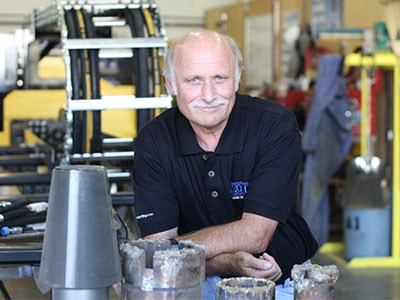Persistence paid off for Ray Roussy.
It’s been a 40-year odyssey for the Smooth Rock Falls native, mechanical engineer and innovator who’s being recognized for nursing a once-discarded commercial drilling technology back to life.
Roussy is a pioneer in sonic drilling, a revolutionary and century-old system that’s gaining worldwide acceptance as an environmentally friendly alternative to conventional drilling systems.
Now his former alma mater, Northern College, has nominated Roussy for the Premier’s Awards for Outstanding College Graduates.
As an owner and manufacturer in British Columbia, Roussy has garnered a number of innovation and technology awards in recent years from the Manning Foundation, the Canadian Geoexchange Coalition, and Nation Ground Water Association in the U.S.
Sonic drilling technology involves a drill head that generates high-frequency vibrations that are transferred down a pipe string to the cutting head, allowing it to advance through geological formations that will stunt conventional drills.
“Diamond drill rigs are great for coring rock, but lousy at coring other material,” said Roussy.
He is president of two companies: Sonic Drilling, a contract division in Surrey, B.C., and Sonic Drill Corporation, a Bellingham, Wash., sales office.
He’s co-owner of Sonic Drill Systems, the manufacturing arm in Chilliwack.
The combined companies employ 30 people.
Sonic drilling can drill three to five times faster than conventional mud rotary or auger drilling, can provide continuous core samples, and is less impactful to the environment because it uses no drilling mud or fluid which can contaminate a work site in sensitive areas.
The technology’s roots date back more than a century to Romanian scientist George Constantinesco, who demonstrated a rock drill prototype based on a percussion system.
By the 1930s, fellow countryman Ion Basgan employed sonic vibrations to a string of drill pipe of a conventional rig which was successful in drilling to greater depths at a faster rate.
This method was used in the Romanian oil fields and was eventually exported for use in the U.S. oil industry in the late 1940s and 1950s.
Roussy was introduced to sonic drilling as a young junior engineer at Hawker Siddeley’s Canadian Car and Foundry plant in Thunder Bay in the early 1970s.
The company wanted to branch out into pile-driving and acquired an unproven version of the technology from California.
His research group soon discovered the machine had major design flaws and wasn’t suited for pile-driving or any type of drilling.
“The idea was to stick a piece of pipe in the ground, vibrate it, and it would go in like butter to any depth,” said Roussy. “The reality was it got stuck as soon as it hit hard ground.”
Roussy figures they built a half-dozen prototypes before Hawker Siddeley gave up.
“The machine at the time was totally unreliable. You could measure the time in minutes that you could operate. The thing would blow up on you. It wasn’t setting up for drilling or long-term use.”
Yet Roussy couldn’t stop tinkering with it after he transferred to Hawker’s Vancouver operation in 1976, and when he left in 1980 to start his own company.
Hawker Siddeley had sold some units to companies doing placer gold exploration.
Even after Hawker abandoned those clients, Roussy kept servicing them, convinced sonic drilling had a huge upside.
“In those years at Canadian Car, I had taken this machine into various areas and I knew that there was a really good marketing potential in the drilling industry.”
After striking out on his own, Roussy naively underestimated the time and money it would take to redesign all the components to build his own rig.
“I was unrealistic about how much stuff costs and I didn’t have the money to invest in development work.”
By 1990, he had pooled enough money to produce a commercially viable and reliable unit with a redesigned drill head.
“That’s the style of machine that we continue to sell today.”
His machines are now used on six continents by some of the world’s biggest construction companies.
“There are a few manufacturers that we sell the complete package (drill rigs and drill heads) to, and we’ve also licensed the technology to a Japanese company for the Asian market.”
The company’s manufacturing division makes a number of portable and tracked mobile rigs that can be easily transported and manoeuvred into remote sites.
The mainstay of their contract work is with engineering companies on environmental investigations and mineral exploration.
On the West Coast, sonic drilling was popular for geothermal energy loop installation in the building industry, but that market cooled when North American natural gas prices dipped.
“It killed the geothermal market,” he said. “Five to seven years ago, everybody was excited about rising energy costs.”
Sonic drilling is also known as a rescue rig when conventional machines fail to punch through underground gravel and boulders. That can affect timelines on a construction project.
“We’ve had quite a few jobs where conventional machines would struggle and take three weeks to do a hole. We just roll up and do a hole in a couple of hours,” said Roussy. “There’s been a number of projects that we’ve rescued.”
At age 66, Roussy could see the end of his professional life looming on the horizon, yet he still finds satisfaction in his work.
“It’s a great racket. I’m 66 years old, so I have to face the reality that I’m not going to kick around forever, but I want to stay involved and I still have a few ideas of what I want to do going forward.”



